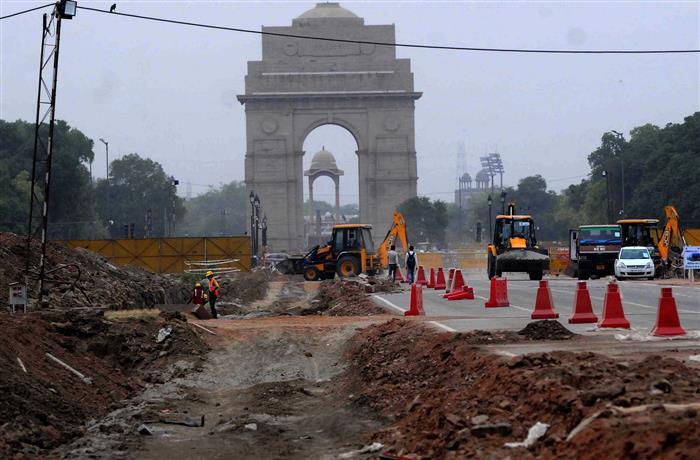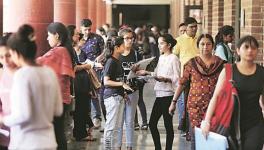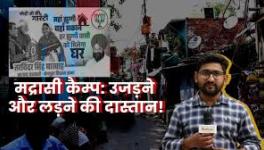Demolish, Rename, Rewrite: How BJP Changes the Past to Control the Future

Post-independence Delhi was a territory engulfed by material infrastructure left behind by the British. To establish an Indian national identity, it needed to exhibit Indian values in public spaces and proclaim self-governance. But how could that be possible with material memories of colonial supremacy visible on such a large scale? Could the undesirable memories be removed? The answer was “no” for several reasons. There were financial constraints, but, more importantly, there were concerns about how to address the past of a new nation that wanted to cast off the shadows of colonial subordination.
Instead of deciding on their own, the administrators took extensive public opinion regarding the restructuring of Central Vista. Subsequently, instead of making an abrupt disconnect with the past, the process of nationalisation was made a continuum. It involved revisiting the past and learning from it rather than denying or overwriting it. In this process, the imperial structures were not entirely or abruptly removed. Certainly, as required for nation-building, the exterior manifestations of British symbols were removed or replaced with Indian ones. But, in other places, they retained the “old touch”. For example, just as a small reminder of times past, the doorknobs of the library entrance in the Rashtrapati Bhagwat preserved their British lion symbol. The understanding was that these structures carry the imprint of colonial rule alongside the history of having won over imperialism to build a new India. It meant choosing a healthy continuity over an unhealthy rupture.
The current regime, however, does not believe in a healthy relationship with the past. With its imagination of India as a Hindu nation, the Bhartiya Janata Party (BJP) has set out to change the past, for it projects a secular history of India. Any history of India that does not establish it as a Hindu nation is an obstacle in fulfilling its Hindu nationalist ideals. Therefore, the BJP wants to destroy all narratives in which diversity and inclusion manifest. A recent and concerning example is the revamping of the Central Vista. The present government is out to change this 35-hectare area of iconic heritage landmarks and public space to “government use”. It will mean demolishing several buildings and re-designing spaces such as Parliament House, Rashtrapati Bhavan, India Gate and the War Memorial.
For decades, Central Vista was the axis of countless lived memories for people who used its spaces. Many prominent heritage conservationists and architects disagree with the excuses given to demolish several buildings that are part of it, as revealed under the plan. Note that the “demolition drive” is not just against colonial heritage: several post-colonial and pre-colonial spaces feature within this plan to demolish public memory.
In April 2017, the BJP-led government demolished the Hall of Nations and halls of industries hosted at the iconic Pragati Maidan exhibition grounds, and far more clandestinely. These buildings, built only in 1972, had marked 25 years of post-colonial Indian fervour. The demolitions in Pragati Maidan wiped out crucial heritage icons ruthlessly and in an autocratic way, ignoring the requests against it by several architects and historians.
The efforts of the BJP in other domains of the past speak of its intentions behind such destructions. It is the longstanding agenda of the right-wing Hindu nationalists to supply a version of history based on ancient religious texts and their Brahmanical interpretation. They have been targeting history textbooks for the same reason: to alter the Indian national narrative, to “purify” past representations and establish a Hindu narrative of the Indian past. They seek to antagonise the people against Muslim rulers, historicise Hindu mythology, and brush aside the historical diversity of India by painting it as a “Hindu Rashtra”.
The first set of history textbooks produced by the NCERT during the 1960s and 1970s had sought to fulfil the broader objectives of secularism, democracy and communal harmony. As these textbooks did not portray the Hindus and the Muslims as mutually antagonistic groups, the Hindu nationalists have been accusing their writers of underplaying the misdeeds of “Muslim invaders”.
Before the BJP came to power at the Centre, its effort to give a Hindutva flavour to school textbooks materialised in the states where it came to power. In 1992, the Centre appointed a steering committee under historian Bipan Chandra, which found that the textbooks published in various states reinforced colonial stereotypes, blamed Muslims for “contaminating” Hindu society and glorified the parent body of the BJP, the Rashtriya Swayamsevak Sangh (RSS).
At the national level, the agenda of the BJP to mythologize history saw the light of the day when it came to power in 1998. The government had all the NCERT textbooks rewritten to produce the Hindu nationalist ideology through a (second set of) textbooks. These textbooks kept academic and secular values aside to create a Hindu nationalist past. In 2004 the “errors” in these textbooks were “corrected” when the BJP went out of power, but when it returned in 2014, its efforts to control the official history of India reappeared.
Since 2014, the attempt to redefine nationalism through history is not ongoing at the mere school textbook level but the university, community and societal level. For example, in March, the University Grants Commission released a new draft syllabus of history that incorporates Hindu mythology.
Public spaces of historical significance are still getting renamed, restructured and redefined. In this tenure, the BJP regime has gone all out to change the names of towns, streets, museums, airports, etc. In 2015, Aurangzeb Road, New Delhi, was renamed APJ Abdul Kalam Road. In 2018, the Mughalsarai Railway station in Uttar Pradesh was renamed Deen Dayal Upadhyaya Railway Station. Last year, Mughal Museum at Agra got renamed Chhatrapati Shivaji Maharaj Museum. The state Chief Minister exclaimed at this renaming, “How can Mughals be our Hero!” Allahabad, named by Mughal ruler Akbar in the 16th century, was renamed Prayagraj in 2018, after a local Hindu pilgrimage. The city is still beautified by its typically Mughal architecture.
Unconcerned about the emotional, social, ecological and financial setbacks of such destructions and restructurings, the government is marching on in despotism. Such radical intolerance of the BJP towards Mughal and Muslim heritage is causing a loss of rich heritage and historical continuity. And it is compromising India’s secular values.
History lives in social symbols and public iconography. It gets communicated by statues, memorials, museums and a host of other structures. The names of our squares and public parks, and our roads, are curated to communicate their respective histories. They inform people about the continuity of their existence, deliver useful knowledge systems, and form our identity. To demolish them is to attack parts of the identity of those who belong to them. History was always a tool to establish the interpretations of social and political events that those who curate it desire. However, the denials and interpretations we now witness are utterly callous and fascist. To erase physical remains and names from official history and implant communal narratives are not just undemocratic acts but forms of symbolic violence.
The author is an Assistant Professor at the National Institute of Advanced Studies, Indian Institute of Science Campus, Bengaluru. The views are personal
Get the latest reports & analysis with people's perspective on Protests, movements & deep analytical videos, discussions of the current affairs in your Telegram app. Subscribe to NewsClick's Telegram channel & get Real-Time updates on stories, as they get published on our website.
























